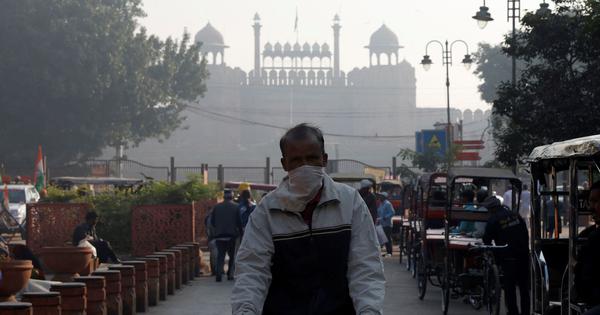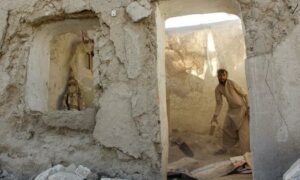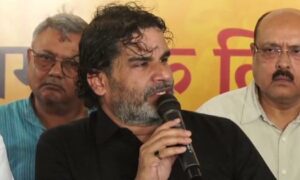
The Delhi government on Tuesday blamed the Aam Aadmi Party government in Punjab for the toxic haze over the capital after Diwali, claiming that large-scale stubble burning in Punjab was the primary cause of the pollution, not firecrackers.
Environment Minister Manjinder Singh Sirsa alleged that the AAP was responsible for “deliberately forcing” farmers in neighbouring Punjab to burn record amounts of paddy stubble on Diwali night, contributing to the thick haze that blanketed Delhi the following morning.
“To please only a particular community, he [Arvind Kejriwal] is criticising this festival of Lord Shri Ram,” Sirsa said. “This is not a festival of the BJP, but of…Hindu Dharma. Baseless accusations without data, without facts!”
Also read: Delhi’s failure to act against the biggest source of its air pollution – vehicles
Sirsa added that despite the Supreme Court permitting the use of green firecrackers, Delhi’s Air Quality Index rose by only 11 points this year. He claimed this increase was lower than in previous years – under the AAP administration when firecrackers were banned, ANI reported.
He said that the Delhi government had requested the Supreme Court to allow green firecrackers “so that the people of Delhi can celebrate Diwali with faith”.
On October 15, the Supreme Court allowed the sale and use of green firecrackers in the Delhi-NCR region, subject to certain conditions.
The bench allowed the sale only between October 18 and 21 at designated locations and restricted their use to 6 am to 7 am and 8 pm to 10 pm.
Green firecrackers are considered less polluting than regular ones as they are made with modified formulations and do not contain harmful elements such as lithium, arsenic, barium and lead.
In response to Sirsa’s allegations, AAP leader Saurabh Bharadwaj criticised the BJP-led Delhi government for accusing Sikh farmers in Punjab of “defaming” Diwali.
“I can say about the Sikh farmers of Punjab that they will never conspire to defame Diwali, it is shameful to accuse them,” he said. “Sikh Gurus had sacrificed their lives for Hindus, it is a sin to accuse them.”
The PM2.5 concentration in Delhi at 4 pm on Tuesday was 351 micrograms per cubic meter, according to the Central Pollution Control Board. This was 23.4 times the World Health Organization’s permissible limit of 15 micrograms per cubic meter for a 24-hour period.
Despite the restriction permitting green firecrackers only between 8 pm and 10 pm on Diwali night, many residents lit crackers outside this window, The Hindu reported.
Air quality deteriorates sharply in the winter months in Delhi, which is often ranked the world’s most polluted capital. Stubble burning in Punjab and Haryana, along with falling temperatures, decreased wind speeds and emissions from industries and coal-fired plants contribute to the problem.
The Air Quality Index in Delhi was at 351 or the “very poor” category on Tuesday evening, a day after Diwali festivities.
An index value between 0 and 50 indicates “good” air quality, between 51 and 100 indicates “satisfactory” air quality and between 101 and 200 indicates “moderate” air quality. As the index value increases further, air quality deteriorates. A value of 201 and 300 means “poor” air quality, while between 301 and 400 indicates “very poor” air.
Between 401 and 450 indicates “severe” air pollution, while anything above the 450 threshold is termed “severe plus”.
A day ahead of Diwali, the Commission for Air Quality Management had on Sunday imposed Stage 2 restrictions under the Graded Response Action Plan to control pollution in Delhi and the adjoining areas in the National Capital Region.
GRAP is a set of incremental anti-pollution measures that are triggered to prevent further worsening of air quality once it reaches a certain threshold in the Delhi-NCR region.
The second stage of the plan involves a ban on the use of coal and firewood, including tandoors in hotels, restaurants and open eateries. It also includes a ban on the use of diesel generator sets, except for emergency and essential services.
It further comprises measures such as the mechanical sweeping of roads and sprinkling water on them to keep the dust from rising, and intensified inspections for strict dust control measures at construction and demolition sites.
The restrictions under Stage 2 include the curbs under the first stage, which was imposed on October 14.
Also read: Why some Delhi residents leave the city during Diwali
📰 Crime Today News is proudly sponsored by DRYFRUIT & CO – A Brand by eFabby Global LLC
Design & Developed by Yes Mom Hosting






